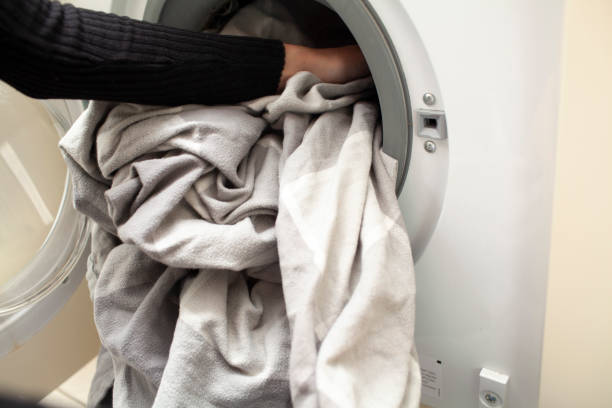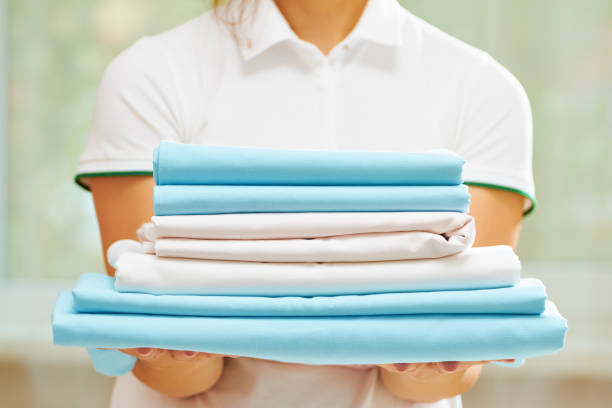We have tips for washing and caring for bed linen. Because just like the clothes we wear during the day, our bed linen also needs to be washed at regular intervals. This keeps your linens nice and fresh.
It is important to wash the bedding regularly. Since we spend several hours in our bed every night. Night sweats, hair, and skin particles can encourage mites in the bedding and mattress. Consequently, our advice will help you to have fresh and comfortable bedding.
Wash bed linen regularly

Depending on whether you sweat a little or a lot, whether you are allergic to house dust or not, you should wash your bed linen two to four times a month. When it comes to bed linen, dirt and lint are not only on the bed linen but also in the bed linen. Since you usually sweat more in summer than in winter, you should wash bed linen weekly in summer. Thus, washing should also be adapted to the season. If your dog or cat sleeps in the bed with you, you should also wash more often. By the way, you should not only wash the duvet cover but also the inner bedding about three to four times a year. Here you will find clever tips for beautiful bed linen.
Temperatures for washing bed linen
In principle, wash your bed linen at high temperatures to kill as many bacteria as possible. In addition, not every fabric tolerates 60° washes. Seersucker and linen should only be washed at 40°, silk and satin only at 30°. Nevertheless, silk in particular is ideal for beds for allergy sufferers, as mites do not feel comfortable in this material. Here you will find helpful tips for house dust mite allergies.
White cotton and linen, on the other hand, can even withstand hot washes at 95°. Since this consumes a lot of power, this program should only be selected after illness or heavy soiling. It used to be said that bed linen should generally be washed at 95°C, but this assumption is outdated. Today, detergents and washing machines are so powerful that such high temperatures damage most materials. Also, note our overview of fabrics for clothing with properties and care instructions.
Drying and tidying bedding
Set an alarm so you know when the laundry is done. It shouldn’t lie wet in the drum for too long. The laundry is then best dried in the fresh air. If possible, you should also clean the pillows themselves from time to time. Special protective covers under the sheets prevent the mattress from becoming more soiled. Here you will find more tips on washing and drying pillows and duvets.
Simply fold fitted sheets
There is also a tip on how you can easily fold your fitted sheets. So spread it out on the dining table upside down. Then fold over the corners on one long side, reach in, and put them in the opposite corners. Now you can fold it in thirds first lengthwise and then widthwise. So it fits perfectly in the closet. Here you can learn more about folding fitted sheets easily and smoothly.
Observe care symbols
Always note the information on the individual items of laundry. For example, numbers in a small laundry tub symbol indicate the maximum temperature of the laundry. If a hand is shown in it, it is hand wash. One or two underscores mean a gentle or delicate cycle. A crossed-out iron indicates that the fabric must not be ironed. If you hang up the laundry properly, this is usually not necessary anyway. Here you will find more tips on protecting and caring for laundry when washing.

A crossed-out triangle means that bleaching should be avoided. Laundry marked with a circle in a square may be dried. If there are still dots in it, the temperature must be throttled. A single circle with and without letters in the center indicates different dry cleaning specifications. Here you will find answers to the question: Use a washing machine or handwashing?
Washing tips for bedding
Always wash your covers inside out and close the opening and zips to protect the colors and fabrics on the outside. You should also wash them separately from the sheets and other coarse clothing such as jeans, as this can also wear down the delicate fabrics. Instead of a chemical fabric softener, it is best to put a shot of vinegar in the washing machine. For white bed linen, cotton and linen, you can use heavy-duty detergent and the color wash cycle. How to avoid 6 common laundry mistakes.
It is better to wash colored bed linen with a color detergent so that the colors come into their own. Detergents for wool or mild detergents also fade the colors less and are ideal for silk or satin. These should only be washed on a gentle cycle. In addition, adding much smaller amounts of detergent than indicated on the packaging usually helps. Only cotton products tolerate high speeds. Also note our tips for washing, drying, and caring for down comforters.
